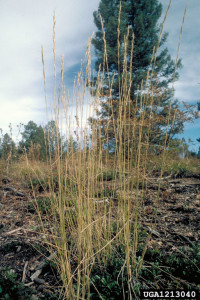Mueggler (1975) has been cited to further the notion that all livestock grazing causes irreparable harm to plants in arid environments unless plants are rested for years after grazing. Below I give a recent example of authors misusing Mueggler (1975) from the following publication:
Carter, J., A. Jones, M. O’Brien, J. Ratner, and G. Wuerthner. 2014. Holistic Management: Misinformation on the Science of Grazed Ecosystems. International Journal of Biodiversity. http://dx.doi.org/10.1155/2014/163431
These authors state: “… bunchgrasses in arid environments are more likely to die if they are heavily grazed by domestic animals [34” AND “Native, western USA bunchgrass species such as bluebunch wheatgrass (Pseudoroegneria spicata) and Idaho fescue (Festuca idahoensis) are sensitive to defoliation and can require long periods (years) of rest following each period of grazing in order to restore their vigor and productivity [34”
Reference 34 is identified in Carter (2014) as: Mueggler, WF. 1975. Rate and pattern of vigor recovery in Idaho fescue and Bluebunch wheatgrass. Journal of Range Management 28:198-204.
Why do I think these statements are misleading? Public land agencies do not condone heavy grazing. Mueggler doesn’t study the likelihood of plants dying from heavy grazing. I couldn’t find any information concerning it in the paper. Defoliation isn’t defined above, but I assume they mean grazing since it is used later in the sentence. However, Mueggler is not a grazing study. It’s a clipping study. Grasses are clipped in or near the boot stage of development, when grasses are most susceptible to both clipping and grazing.
To apply this clipping study to any livestock grazing in an arid environment, one must assume:
- Clipping and grazing affect plants equally.
- The species of concern are either bluebunch wheatgrass or Idaho fescue. If not, then all plants respond the same way to grazing.
- All plants in the community are grazed to the same level of clipping used by Mueggler.*
- The entire plant, and not just part of the plant, will be grazed.
- Plants are grazed at or near boot-stage of development.
- The same climatic conditions that occurred during Mueggler are present.
- The same history of grazing, that occurred prior Mueggler, exists.
- Plants grow on the same aspect, slope, and soil type as in Mueggler.
- Soils have the same nutrient levels as those present in Mueggler’s study.
- Plants are growing in the same plant community that occurred at Mueggler’s study site.
- Grazing a plant not in full vigor, which is a very vague term, is detrimental to plants and the grassland as a whole at a landscape level.
*Bluebunch wheatgrass was clipped to remove 50% of the plant by weight. For Idaho fescue, the clipping was so severe that it cannot be equated with any grazing management plan.
The statements made by Carter et al. (2014) ignore grazing studies by Ganskopp and Bedell (1981) in eastern Oregon. They showed that: 1) Lightly (0%-25% utilization) grazed Idaho fescue and bluebunch wheatgrass (BBWG) produced as much or more height, weight, and seed stalks as ungrazed plants; 2) No differences were detected between moderately (25%-70% utilization) grazed and ungrazed BBWG and fescue plants; 3) Heavy grazing (above 70% utilization) reduced production and height of fescue, but did not significantly impact BBWG; and 4) No plants died from grazing treatments.
Also, Rickard et al. (1975) working in eastern Washington concluded that clipping studies do not mimic cattle grazing. They also reported that many years of moderate grazing could likely be sustained before pronounced shifts in plant species composition and abundance, including BBWG, are noticed.
Finally, a clipping study by Clark et al. (1998) discovered plants that when only ½ of their basal area was clipped to a 3” stubble height during mid-boot, it increased their basal area by 18.6%. In comparison, the basal area of unclipped plants only increased by 5.2% by the end of the growing season.
References
Clark, PE, WC Krueger, LD Bryant, and DR Thomas. 1998. Spring defoliation effects on bluebunch wheatgrass: II. Basal area. Journal of Range Management 51:526-530.
Ganskopp, DC and TE Bedell. 1981. An assessment of vigor and production of range grasses following drought. Journal of Range Management 34:137-141.
Rickard, WH, DW Uresk, and JF Cline. 1975. Impact of cattle grazing on three perennial grasses in south-central Washington. J. Range Manage. 28:108-112

